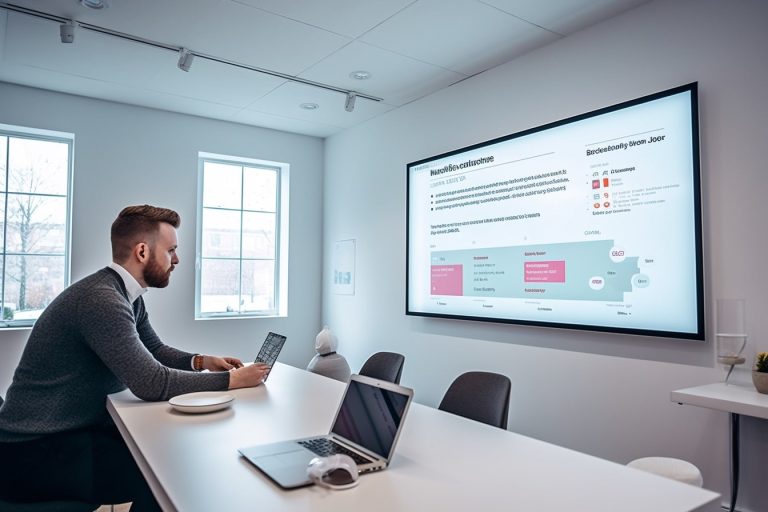How to Personalize Content on Your WordPress Blog
Ever wondered why some blogs grab your attention but others don’t? It’s all about content personalisation. By customising your content for readers, your WordPress blog can attract and retain users more effectively.
Want to engage your blog readers better? Content personalisation is key. This article will show you how to tweak your WordPress content. We’ll cover understanding user behaviour, using personalisation tools, and how to dynamically change content. We’ll also explore ways to personalise your posts and display settings.
Key Takeaways
- Understanding user behaviour is essential for effective content personalisation on your WordPress blog.
- Analysing visitor data, heatmaps, and session recordings helps in gaining deep insights into audience engagement.
- Segmenting your audience enables you to tailor content to meet diverse user preferences.
- Implementing the right personalisation tools can transform the user experience on your blog.
- Dynamic content adjustment through the WordPress editor, customiser, and block patterns can enhance content relevancy.
- Customising post templates and display options are key strategies to make your content appealing and engaging.
Understanding User Behaviour
Understanding how users behave on your WordPress blog is crucial. By looking at visitor data, you can spot trends and the type of content they prefer. This knowledge leads to better engagement and more conversions.
Analysing Visitor Data
Looking into various metrics such as page visits and how long visitors stay is key. Using website analytics, heatmaps, and surveys offers a complete picture of how users interact. This helps in creating content that connects well with your audience, improving conversion rates.
Utilising Heatmaps and Session Recordings
Heatmaps and session recordings visually show how users navigate your site. They reveal what areas are most engaging and how far people scroll. With this information, you can make your blog more user-friendly and engaging.
Segmenting Your Audience
Dividing your users based on their behaviour and location lets you customise content for each group. Personalised content boosts the user experience. It leads to higher engagement and loyalty, making your blog more successful.
Implementing Personalisation Tools
Adding personalisation tools to your WordPress blog makes it dynamic and user-friendly. By using the right WordPress plugins and third-party integration, we create content that meets users’ needs. Importantly, 90% of marketers say personalisation boosts business profits, highlighting its value.
Choosing the Right Plugins
The first step is picking the best WordPress plugins for your blog. With so many choices, it’s crucial to find plugins that fit your blog’s aims and the interests of your audience. OptinMonster works well to turn visitors into subscribers with effective popup campaigns. Elementor Pro is great for making personalised landing pages that catch user interests. Choosing plugins that are easy to use helps smoothly bring your personalisation vision to life.

Integrating Third-Party Tools
Third-party integration takes content personalisation up a notch. Adobe Experience Manager (AEM) is excellent for creating content targeted at different audience segments. It uses rules to match user data with audience types, making sure the right content reaches the right people. Also, Amazon’s personalisation engine, which makes about $1 billion daily, shows the success you can achieve with these tools. They help us understand user behaviour better, leading to happier and more engaged visitors.
Though many marketing leaders find it hard to expand their personalisation efforts, the right WordPress plugins and third-party tools can overcome this. Adopting these methods not only boosts user interaction but also builds a devoted audience that loves custom content. Let’s use these advanced tools to make our WordPress blogs interactive and more appealing.
Dynamic Content Adjustment
Adjusting content dynamically on your WordPress blog is key to engaging your users personally. By using different tools and features of WordPress, you can change your content to suit your audience’s unique needs. This makes your blog more personal and engaging.
Utilising the WordPress Editor
The WordPress editor is essential for content adjustment. It makes editing pages and posts filled with media easy, letting you customise with ease. Whether it’s videos, images, or text, the WordPress editor’s flexible interface boosts your blog’s content.
Using the Customiser
The customiser in WordPress is great for tweaking classic theme content options. You can change colours, fonts, and layouts in real time. This adapts your site to match your audience’s likes, increasing their interest. Also, McKinsey says 71% of consumers want personalised experiences, making the customiser key.
Creating Block Patterns and Page Layouts
Using page layouts and block patterns is crucial for quick content adjustment. These let you design consistently across pages, saving time and ensuring a unified style. Block patterns help message various customer segments in one go. Braze found using personalised content increased click-through rates by 126% for busuu.
Using the WordPress editor, customiser, and block patterns helps create a tailored and dynamic content experience. This meets modern users’ high expectations, boosting their interaction with your blog.
Content Personalization Strategies
To personalise your WordPress blog well, you need strong strategies. These include changing post templates and how content looks.
Customising Post Templates
Customising post templates is a key first step. You change layouts using theme blocks to match your audience’s tastes. HubSpot, Optin Monster, and Episerver help with this.
According to HubSpot, 90% of marketers say personalisation boosts business success. This shows why changing your post templates is vital.
Adjusting Content Display Options
Making smart changes to how content is shown is also crucial. This means adjusting elements like images, author bios, and post details. When done right, it makes people interact more with your content.
Amazon and Netflix use tools like collaborative filtering to suggest targeted content, improving user engagement. Such techniques can lead to more loyal customers and better sales.
Using detailed customer data helps make your content match user needs better. But 71% of customers get annoyed when content isn’t personalised. So, personalising your WordPress content well is key to keeping your audience happy and loyal.
Conclusion
Content personalisation on a WordPress blog is more than just adding special touches. It’s all about making your blog more engaging and driving higher conversion rates. By analysing how users interact with the blog, we can create content that really speaks to them. This involves looking at things like how often they click, how long they stay, and if they quickly leave the page.
We use this info to create user personas. These personas help us deliver content that feels tailor-made for different groups of readers.
Choosing the right tools for personalisation is also key. With things like recommendation algorithms, we can suggest content that users will likely enjoy. This can mean changing how posts look, what content gets shown first, or using dynamic features in WordPress. Each step makes the blog more exciting to your audience.
However, personalising content does come with its own set of challenges. We can’t overlook the importance of data privacy, content quality, and how to scale these efforts. But, by focusing on what readers like and how they browse, as well as using smart segmenting and recommendations, these challenges can be tackled. When done right, personalisation can really make a blog stand out, keep readers coming back, and increase engagement.








